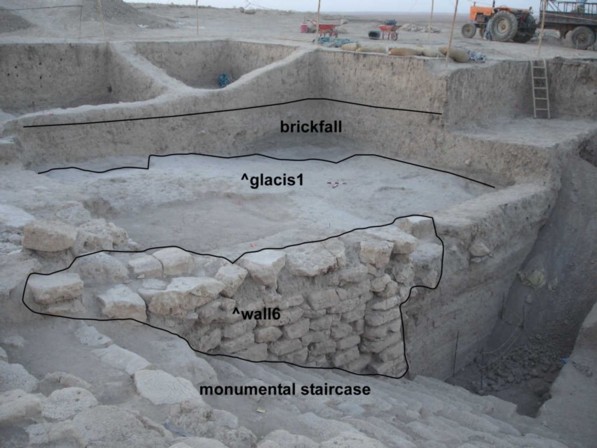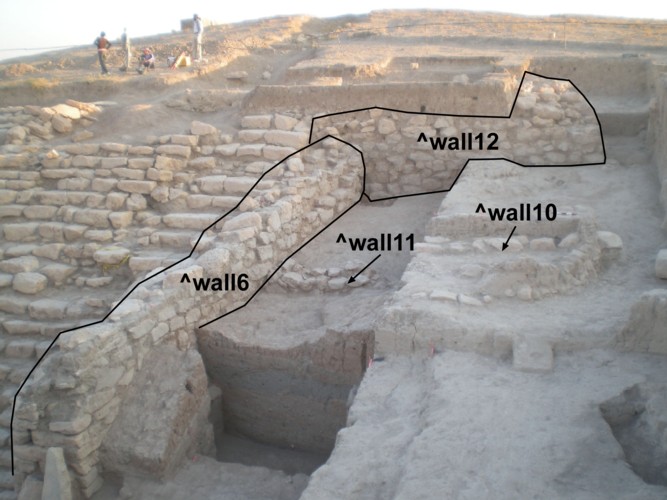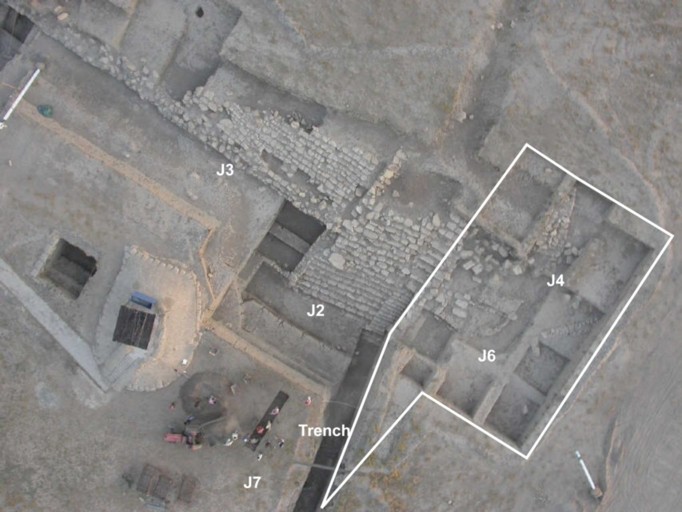Back to top: Overview of Unit J6
Phisiognomy
The physiognomy of J6 is defined by the particular context of the area, by the architectural finds and by the stratigraphy.
Back to top: Overview of Unit J6
Mittani Brickfall
The first important find in J6 area was a large brickfall ^bf1 and ^bf2 covering all the unit originating outside of J6 (to the east) and continuing through J7 and in the southern lower portion of J2. The J6 brickfall covers approximately an area of 40mq (only the exposed portion) and is about 2 meters thick. The discovery of the brickfall changed the strategy of the excavations and our understanding of the use of the eastern portion of the temple terrace in its latest phase. We decided to expose it all and to search the source of the collapse. This collapse was generated by a large structure east of the terrace (not excavated) and thus implying the presence of buildings to the east of the Plaza, possibly service areas for the temple. On the other hand, the collapse of those structures is one reason for the shift, during Mittani, of the main entrance to the terrace to the west in J5.
 Looking South
Looking South
Back to top: Overview of Unit J6
The glacis and escarpment
The brickfall in J6 covered a hard and compact layer sloping down toward the south-east. It started from the east flanking wall of the staircase ^wall6. Given the characteristics of the layer and its function, we called it ^glacis1. The glacis was laid during Mittani and had a similar function as the earlier ^glacis3: they both were laid to protect the eastern side of ^wall6.
 Looking South
Looking South
Back to top: Overview of Unit J6
Eastern flanking staircase wall
One of the main goal in J6 was to uncover ^wall6 flanking to the east the monumental staircase in J2. We knew that the wall flanked all the staircase, since the western face and the top of the wall was exposed during excavations in J2 (seasons 2004 and 2005). We supposed that the wall would make a bend at a 90° angle and continue to the east, serving as the southern edge of the terrace. During the 2008 season we were able to expose the southern end of the wall, which terminated with two stelae. The wall terminated here and did not continue to the east. From this moment, the physionomy of J6 excavation area and the strategy changed: we decided to go down only along ^wall6 in loci k82, k83, k84, k85
 Looking West
Looking West
Back to top: Overview of Unit J6
Eastern terrace revetment wall
The search of the eastern continuation of the terrace wall affected the physiognomy of the J6 excavation area: we concentrated the excavation directly east of ^wall6; firstly we supposed it would continue perpendicular to it. Since no wall was found, we decided to excavate few meters north: here a single line of stones (^wall10), was found, running east-west and following the alignment of the revetment wall in J2, thus leading us to think that it would continue here. In fact we exposed a wall in this location ^wall11, which is not the terrace wall. Therefore we moved to the north, directly east of the last step of the monumental staircase in J2, where we exposed ^wall12, which is the long searched terrace wall.
 Looking north-east
Looking north-east
Back to top: Overview of Unit J6
The pertinent areas
JP is the main area to which unit J6 belongs. It refers broadly to the area that includes the Plaza and the monumental stone structure which delimits the temple terrace on the south, including the monumental staircase in J2, the terrace wall in J3, J1 and J5 and the second staircase in J5.
 Overhead
Overhead
Back to top: Overview of Unit J6
Location
Unit J6 is located directly East of J2, excavated for two years and previously investigated by a series of trenches which discovered the monumental terrace access (JP T11-B T13: ZOrA 1, 2008, 396-433). J6 is the eastern limit of the temple terrace, east of the flanking wall of the monumental staircase: J6 is therefore stratigraphically linked to J2 for the southern portion, whereas for the northern portion subsumes J4, excavated in season 2006.
 Overhead
Overhead
Back to top: Overview of Unit J6
Phases
Phase 7m-J6A 7g-J6A: Abandonment: a thick layer of natural accumulations covers the first meter of the area.
Phase 7e-J6A Mid Mittani: A dump of pottery and garbage ^dump1 covers almost all the unit; before this, buildings collapse ^bf1 covering J6 and the lower portion of J2, blocking the first steps of the monumental staircase.
Phase 7d-J6A Mid/Early Mittani: Construction and use of the bin a7. Reorganization of the eastern side of the monumental access, with memory stones and glacis: the area is free of structures and clean. Two hollow pits remove partly the glacis and other structures.
Phase 4m-J6A Late Akkadian: Floors in front of the stele connect the eastern area of J6 to the monumental access in J2. A packing of red earth ^glacis3 is laid east of the flanking staircase wall, in order to protect its base
Phase 3s-J6A Late EDIII: Dump ^dump2 of pottery from a kiln.
Phase 3p-J6A Late EDIII: Construction of ^wall11 perpendicular to the eastern flanking staircase wall.
Phase 3m-J6A EDIIIA: Construction of the monumental staircase, terrace enclosure wall, ‘betili’.
Phase 3l-J6A EDIIIA:surface of terrace mound before the construction of the staircase: several floors slope markedly to the south in a south-eastern direction under ^wall6.
 Looking north
Looking north
Back to top: Overview of Unit J6
Excavations in 2008
Excavations began on July 13 and ended August 28, 2008. J6 was divided in eight loci, where k86 and k87 are not regular loci, while they are cut by the north-south trench (T11 made by the DOG team in yeas 1998-2001, ZOrA 1, 2008, 396-433). k64, k74, k84 were excavated in season 2007 as a J4 loci: they were re-opened since in this location we expected to find the east-west oriented wall bonding the eastern portion of the terrace. k75, k85 and k65 are new loci, opened to allow a better view for the expected wall. k86 and k87 were opened both to allow a better view of the expected wall and to open the view for the monumental staircase when approaching from the south, together with J7. The main result of season 2008 was the discovery of the large brickfall and the exposure of the southern end of the flanking wall for the staircase.
 Looking south
Looking south
Back to top: Overview of Unit J6
Excavations in 2009
Excavations began on July 20 and ended 27 August 2009. We first began excavating in k104, with the aim to find the eastern continuation of the terrace wall: a line of stones (marked with a dotted red line) in k73 and k104 led us to suppose that the wall would follow the same orientation of the revetment wall in J2. Since the stones were only one line set on top of a hollow pit, we moved to the north in k82, looking for another possible location of the wall: in k82 and k71 was a wall already exposed in 1999 and cleaned in season 2006, good candidate for the terrace wall (marked with a red line): the excavation therefore expanded to the north-east in k71 and k70. In k72 and k72 we decided only to clean up so that in case we should find something in k104, we would open also these loci.
Goal for k106 was finding floors associated with the obelisks, east of the trench; Excavations proceded alongside those in J2 (1 meter to the west in front of the staircase) with the aim of dating the building of the staircase. k106 therefore was important in terms of chronology and linking the construction of the flanking wall to the construction of the staircase.
 Overhead
Overhead
Back to top: Overview of Unit J6
Goals for next excavation seasons
Now that the eastern portion of the terrace wall is found, other issues arise: how does the wall continue? Does it continue north, bonding very asymmetrically with the terrace, or does it continues to the east? Just the area north of J6 (marked in blue)should yield much information about (1) the continuation of the wall and (2) the mudbrick glacis coating the terrace: the alignment of the staircase does not lead directly to the temple; how does it continues? with a path? low steps? (3) the nature of the terrace.
For J6 properly would be interesting to excavate further the wall parallel to the terrace wall, a few meters to the south. Does it continue east? what function does it have?
Another structure is located under the main staircase, possibly an earlier staircase belonging to a previous construction phase: it is located in J2 but it continues to the east in k84.

Back to top: Overview of Unit J6
Main results
The main results in J6 may be summarized as follows:
- The large brickfall of a building to the south-east of the terrace
- The glacis
- The packing on the back of the eastern flanking wall of the monumental access
- The orthostats
- The eastern bend of the terrace enclosure wall
- The surface of the mound under the staircase wall
- The seals
Back to top: Overview of Unit J6
General statistics
| approximate cubic meters | 350 |
| total number of features | 355 |
| total number of items | 610 |
| total number of q-lots | 500 |
| total number of sherds | - |
| total number of output files | [not processed in this version] |
| total number of records | [not processed in this version] |
| total number of hyperlinks | [not processed in this version] |
| total number of photographs | 491 |
| total number of drawings | [not processed in this version] |
| total file size (with low resolution graphic files) | [not processed in this version] |
Back to top: Overview of Unit J6